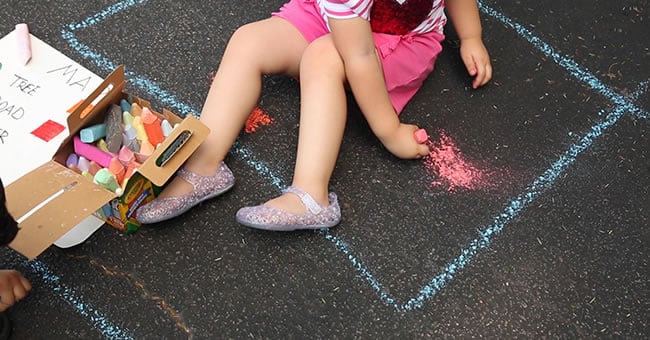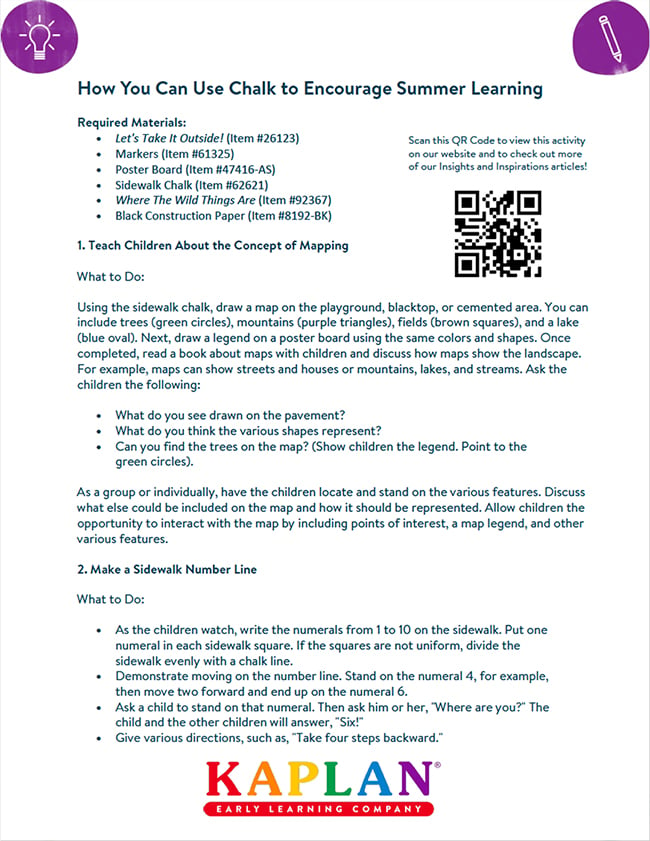
Chalk is a simple and versatile tool you can use to teach children a variety of concepts in math, science, literacy, and other subjects. From having children write their names in chalk on the sidewalk to playing a game of hopscotch math, the learning possibilities are endless! Chalk activities are perfect for the classroom or for families to do together at home during the summer months. Check out these three chalk activities to encourage summer learning adapted from Let's Take It Outside!
Download our FREE printable below!

Required Materials:
- Let's Take It Outside! - Paperback
- Markers
- Poster Board
- Sidewalk Chalk
- Where The Wild Things Are - Paperback
- Black Construction Paper
1Teach Children About the Concept of Mapping
What to Do:
Using the sidewalk chalk, draw a map on the playground, blacktop, or cemented area. You can include trees (green circles), mountains (purple triangles), fields (brown squares), and a lake (blue oval). Next, draw a legend on a poster board using the same colors and shapes. Once completed, read a book about maps with children and discuss how maps show the landscape. For example, maps can show streets and houses or mountains, lakes, and streams. Ask the children the following:
- What do you see drawn on the pavement?
- What do you think the various shapes represent?
- Can you find the trees on the map? (Show children the legend. Point to the green circles).
As a group or individually, have the children locate and stand on the various features. Discuss what else could be included on the map and how it should be represented. Allow children the opportunity to interact with the map by including points of interest, a map legend, and other various features.
2Make a Sidewalk Number Line
What to Do:
- As the children watch, write the numerals from 1 to 10 on the sidewalk. Put one numeral in each sidewalk square. If the squares are not uniform, divide the sidewalk evenly with a chalk line.
- Demonstrate moving on the number line. Stand on the numeral 4, for example, then move two forward and end up on the numeral 6.
- Ask a child to stand on that numeral. Then ask him or her, "Where are you?" The child and the other children will answer, "Six!"
- Give various directions, such as, "Take four steps backward."
- Have all the children count with the child on the number line as he or she walks or jumps four steps backward. Ask him or her, "Where are you?" The child and the other children will answer, "Two!"
- Give the child another direction, such as, "Take three steps forward. Where are you?" Continue with another child.
- Sing this song to the tune of "Do You Know the Muffin Man?" Oh, I am on the number line, the number line, the number line. Oh, I am on the number line, moving up and down. I like to count on the number line, the number line, the number line. One, two, three, four, five, six, seven, eight, nine, ten.
3Track Changing Shadows
This activity will be completed over time during the day; plan your schedule accordingly. Locate a large area on a sidewalk or the blacktop that receives full sun throughout the day.
What to Do:
- Point out their shadows to the children.
- Ask the children if they know what makes a shadow. Explain that when we stand in the way of the sun's rays, we cast a shadow. As the sun moves throughout the day, our shadows move, too.
- Ask one child to stand feet together on the sidewalk. (If necessary, reposition the child so his or her shadow is totally on the sidewalk.) Trace around the child's shoes with chalk. Draw a line at the top of the child's shadow. Write the child's name and the time on the line and his or her name on the shoe tracing.
- Invite other children to have their feet outlined, to help draw around the feet, and to mark lines at the top of the shadows. Label each shoe tracing with the child's name and each line with both the name and the time.
- After an hour, come back to the shadows. Ask the children to stand on their feet outlines. Ask, "What has happened to your shadow?" (The children may explain that the shadow shortened, got smaller, lengthened, grew, or changed direction.) Mark a new line and label it.
- Continue this process throughout the day. Shadows will shorten during the morning hours, nearly disappear at noon, and lengthen in the afternoon.
Draw up some more outdoor fun with this activity and more! Browse our selection of products and resources to support art and outdoor learning and related resources to welcome summer wishes and plan creative activities and crafts.
